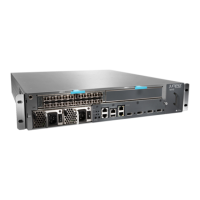This chapter provides an overview of how redundant host modules, host subsystems,
and Routing Engines work on various routing platforms. Additionally, it describes the
topics as listed in Table 135 on page 564.
Action Table 135: Checklist for Host Redundancy
Command or ActionMonitor Redundant Routing Engine Tasks
“Routing Engine, Host Module, and Host Subsystem Redundancy Connections” on
page 570
“Determine Which Routing Engine You Are
Logged In To” on page 575
show chassis routing-engine1. Determine Which Routing Engine You Are
Logged In To on page 575
show chassis hardware2. Display the Router Hardware on page 576
Routing Engine Mastership
show chassis routing-engine1. Determine the Routing Engine Mastership by
Checking Status on page 577
Physically check the LEDs on either the
craft interface or the Routing Engine
(depending on which chassis the Routing
Engine is installed).
2. Determine Routing Engine Mastership by
Checking the LEDs on page 578
request routing-engine login
other-routing-engine
3. Log in To Backup Routing Engine If Graceful
Switchover is Configured on page 578
For slot 0:
[edit]
set chassis redundancy routing-engine 1
master
commit
For slot 1:
[edit]
set chassis redundancy routing-engine 0
backup
commit
“Manually Configure Master and Backup
Routing Engines” on page 578
request chassis routing-engine master
(acquire | release | switch)
“Manually Switching Routing Engine
Mastership” on page 581
show log mastership
“Determining Why Mastership Switched” on
page 582
show log mastership
set chassis redundancy keepalive-time
300
commit
“Configuring the Backup Routing Engine to
Assume Mastershipon Failure of Keepalives”
on page 585
“Avoid Redundancy Problems” on page 586
Copyright © 2012, Juniper Networks, Inc.564
M Series and T Series Routers Monitoring and Troubleshooting Guide

